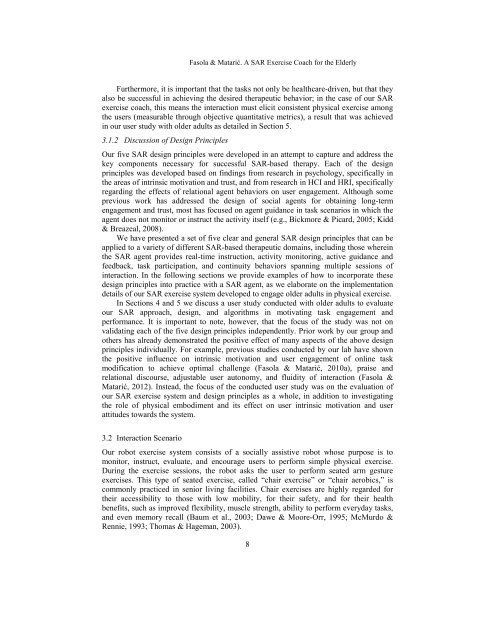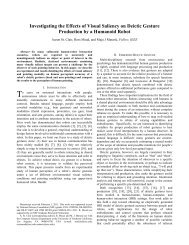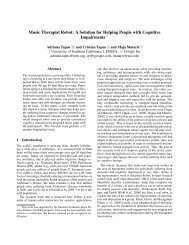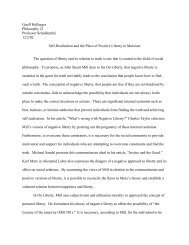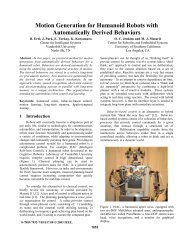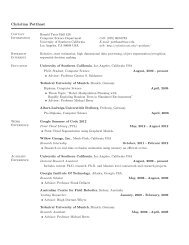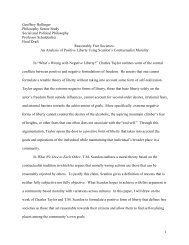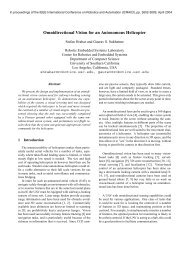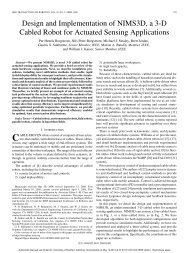A Socially Assistive Robot Exercise Coach for the Elderly
A Socially Assistive Robot Exercise Coach for the Elderly
A Socially Assistive Robot Exercise Coach for the Elderly
Create successful ePaper yourself
Turn your PDF publications into a flip-book with our unique Google optimized e-Paper software.
Fasola & Matarić. A SAR <strong>Exercise</strong> <strong>Coach</strong> <strong>for</strong> <strong>the</strong> <strong>Elderly</strong>Fur<strong>the</strong>rmore, it is important that <strong>the</strong> tasks not only be healthcare-driven, but that <strong>the</strong>yalso be successful in achieving <strong>the</strong> desired <strong>the</strong>rapeutic behavior; in <strong>the</strong> case of our SARexercise coach, this means <strong>the</strong> interaction must elicit consistent physical exercise among<strong>the</strong> users (measurable through objective quantitative metrics), a result that was achievedin our user study with older adults as detailed in Section 5.3.1.2 Discussion of Design PrinciplesOur five SAR design principles were developed in an attempt to capture and address <strong>the</strong>key components necessary <strong>for</strong> successful SAR-based <strong>the</strong>rapy. Each of <strong>the</strong> designprinciples was developed based on findings from research in psychology, specifically in<strong>the</strong> areas of intrinsic motivation and trust, and from research in HCI and HRI, specificallyregarding <strong>the</strong> effects of relational agent behaviors on user engagement. Although someprevious work has addressed <strong>the</strong> design of social agents <strong>for</strong> obtaining long-termengagement and trust, most has focused on agent guidance in task scenarios in which <strong>the</strong>agent does not monitor or instruct <strong>the</strong> activity itself (e.g., Bickmore & Picard, 2005; Kidd& Breazeal, 2008).We have presented a set of five clear and general SAR design principles that can beapplied to a variety of different SAR-based <strong>the</strong>rapeutic domains, including those wherein<strong>the</strong> SAR agent provides real-time instruction, activity monitoring, active guidance andfeedback, task participation, and continuity behaviors spanning multiple sessions ofinteraction. In <strong>the</strong> following sections we provide examples of how to incorporate <strong>the</strong>sedesign principles into practice with a SAR agent, as we elaborate on <strong>the</strong> implementationdetails of our SAR exercise system developed to engage older adults in physical exercise.In Sections 4 and 5 we discuss a user study conducted with older adults to evaluateour SAR approach, design, and algorithms in motivating task engagement andper<strong>for</strong>mance. It is important to note, however, that <strong>the</strong> focus of <strong>the</strong> study was not onvalidating each of <strong>the</strong> five design principles independently. Prior work by our group ando<strong>the</strong>rs has already demonstrated <strong>the</strong> positive effect of many aspects of <strong>the</strong> above designprinciples individually. For example, previous studies conducted by our lab have shown<strong>the</strong> positive influence on intrinsic motivation and user engagement of online taskmodification to achieve optimal challenge (Fasola & Matarić, 2010a), praise andrelational discourse, adjustable user autonomy, and fluidity of interaction (Fasola &Matarić, 2012). Instead, <strong>the</strong> focus of <strong>the</strong> conducted user study was on <strong>the</strong> evaluation ofour SAR exercise system and design principles as a whole, in addition to investigating<strong>the</strong> role of physical embodiment and its effect on user intrinsic motivation and userattitudes towards <strong>the</strong> system.3.2 Interaction ScenarioOur robot exercise system consists of a socially assistive robot whose purpose is tomonitor, instruct, evaluate, and encourage users to per<strong>for</strong>m simple physical exercise.During <strong>the</strong> exercise sessions, <strong>the</strong> robot asks <strong>the</strong> user to per<strong>for</strong>m seated arm gestureexercises. This type of seated exercise, called “chair exercise” or “chair aerobics,” iscommonly practiced in senior living facilities. Chair exercises are highly regarded <strong>for</strong><strong>the</strong>ir accessibility to those with low mobility, <strong>for</strong> <strong>the</strong>ir safety, and <strong>for</strong> <strong>the</strong>ir healthbenefits, such as improved flexibility, muscle strength, ability to per<strong>for</strong>m everyday tasks,and even memory recall (Baum et al., 2003; Dawe & Moore-Orr, 1995; McMurdo &Rennie, 1993; Thomas & Hageman, 2003).8


